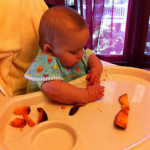Before I launch into my post, I don’t want to seem as if I’m pushing one feeding method over another. I voluntarily chose to not breastfeed (after trying for 6 weeks) for multiple reasons – the primary one being my sanity. I support any woman in whichever choice she makes to feed her child, whether voluntarily or involuntarily. This is simply a post about how you would save money if you breastfeed.
Daughter Person was fed breast milk (notice I didn’t say breastfed) for almost 6 weeks. She spent a week in the NICU and I had to pump, which created a *huge* supply/demand issue when she got out, and she would never actually latch. After watching Dad or my mom feed my daughter because I was pumping instead, I said to hell with it, and we went out and bought formula – and I personally feel that it was one of the best decisions of my life. It also makes me a little more qualified to compare the cost of the two 🙂
Bottles are required for formula feeding, but not for breastfeeding (but you’ll probably still buy some anyway so you can take a break), so I’m not including the prices of bottles in this calculation.
Costs of Breastfeeding
(Optional) pump: $200
(Optional) milk storage bags: $12 for 50ct
(Optional) nursing clothing: $50-$100
(Optional) nursing pillow: $45-$65
(Optional) reusable breast pads: $15
Total optional items: $322 – $392
Notice that all of these things are listed as “optional”? They weren’t for me, but they’re not really *required* to nurse a child.
Costs of Formula Feeding
We were *very* lucky in that Daughter Person did not have any special needs or allergies where we needed special formula. If your child does have such needs, triple or quadruple the numbers below.
We used Kirkland (Costco) brand formula for Daughter Person, $17/canister, and each canister made 262 oz of formula – $0.15/oz. When you formula feed, you *will* make too much formula at once and have to throw some out, so I’m using the amounts we actually made, not just what Daughter Person actually drank. Daughter Person also drank very little compared to some of my friends’ children, so these would just be estimates for any other child, and probably on the low side.
From 6 weeks when we ran out of frozen breast milk to about 2 months, Daughter Person drank 2-3oz per bottle, and 8 bottles per day (and night). That’s 24oz per day for 2 weeks: $50.40
From 2 months to 4 months, she drank about 4oz per bottle, and still drank 8 per day. That’s 2 months (60 days), at 32oz per day: $288
From 4 months to 6 months, she drank 6 oz per feeding and had about 6 feedings per day: $324
Then from 6 months to a year, she drank about 4 feedings of 6oz each per day: $648 At that point, we switched to whole milk. We started feeding her solid food at 6 months, and she slowed down on formula consumption at that point.
Some kids drink as much as 8oz or more at a feeding when they get close to 6months, but not Daughter Person, so your mileage may vary.
Total costs: $1,310.40
Savings
You could save anywhere from $1,000 to $1,500 (or more if you need to use a special formula) by exclusively breastfeeding, so it’s a good economical choice if you have that option.

